Energy Geography: Industrial Revolution, Transition & Alliances
VerifiedAdded on 2022/08/18
|24
|7229
|16
Report
AI Summary
This research paper delves into the pivotal role of energy during the industrial revolution and its impact on global economies, with a specific focus on just transitions in South Africa and South Korea. The paper examines the shift from agrarian societies to industrialized ones, highlighting the development of machine tools, factory systems, and new energy sources like coal and steam. It analyzes the objectives, methodology, and case studies, including the first industrial revolution in Britain and the just transition in South Africa. The analysis explores the role of energy, the concept of just transition, and the comparison between South Africa and South Korea's approaches. The paper also suggests potential alliances for South Africa to manage the transition to sustainable energy sources. The research utilizes secondary sources and case studies to provide a comprehensive understanding of the complex interplay between energy, industrialization, and socioeconomic changes.
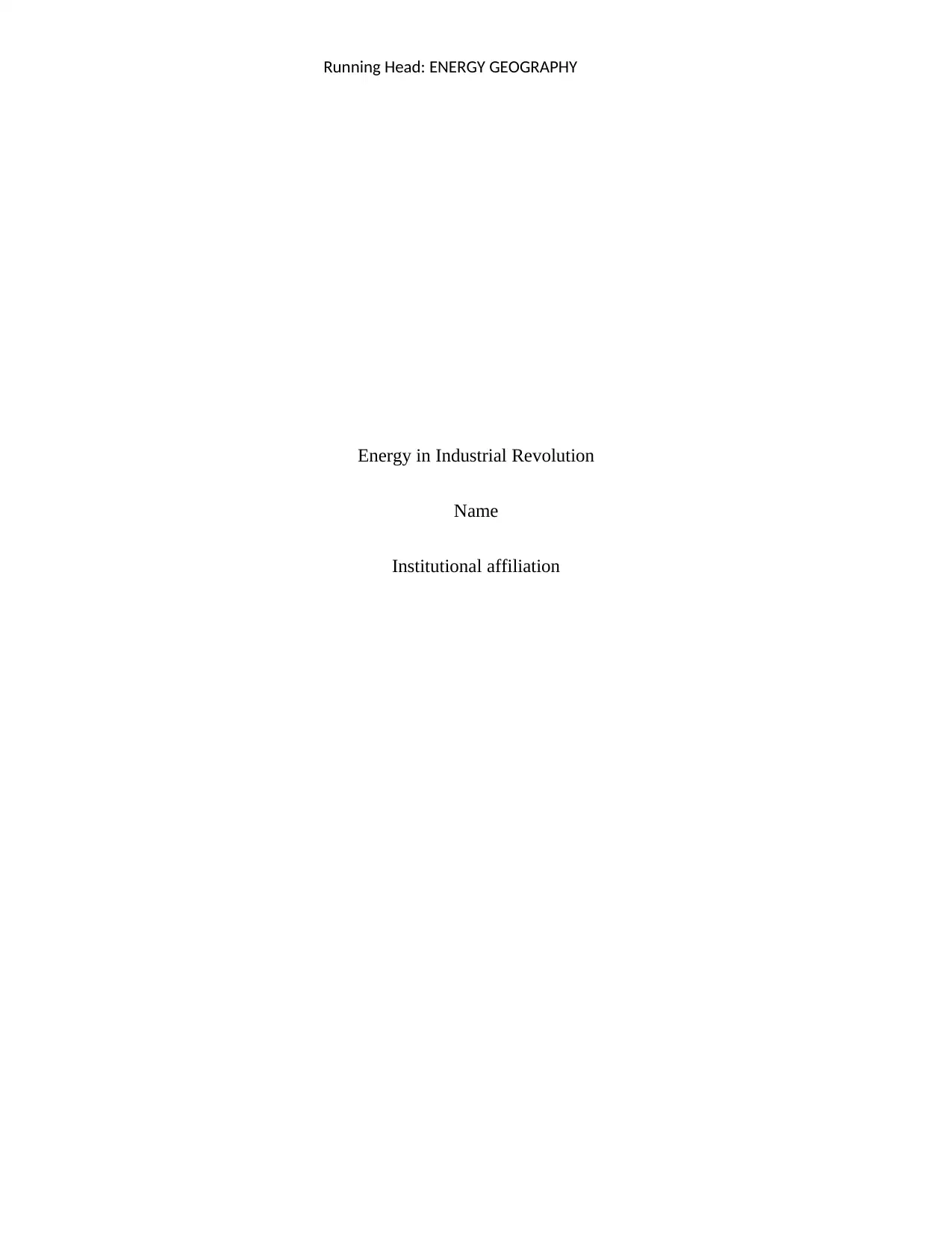
Running Head: ENERGY GEOGRAPHY
Energy in Industrial Revolution
Name
Institutional affiliation
Energy in Industrial Revolution
Name
Institutional affiliation
Paraphrase This Document
Need a fresh take? Get an instant paraphrase of this document with our AI Paraphraser
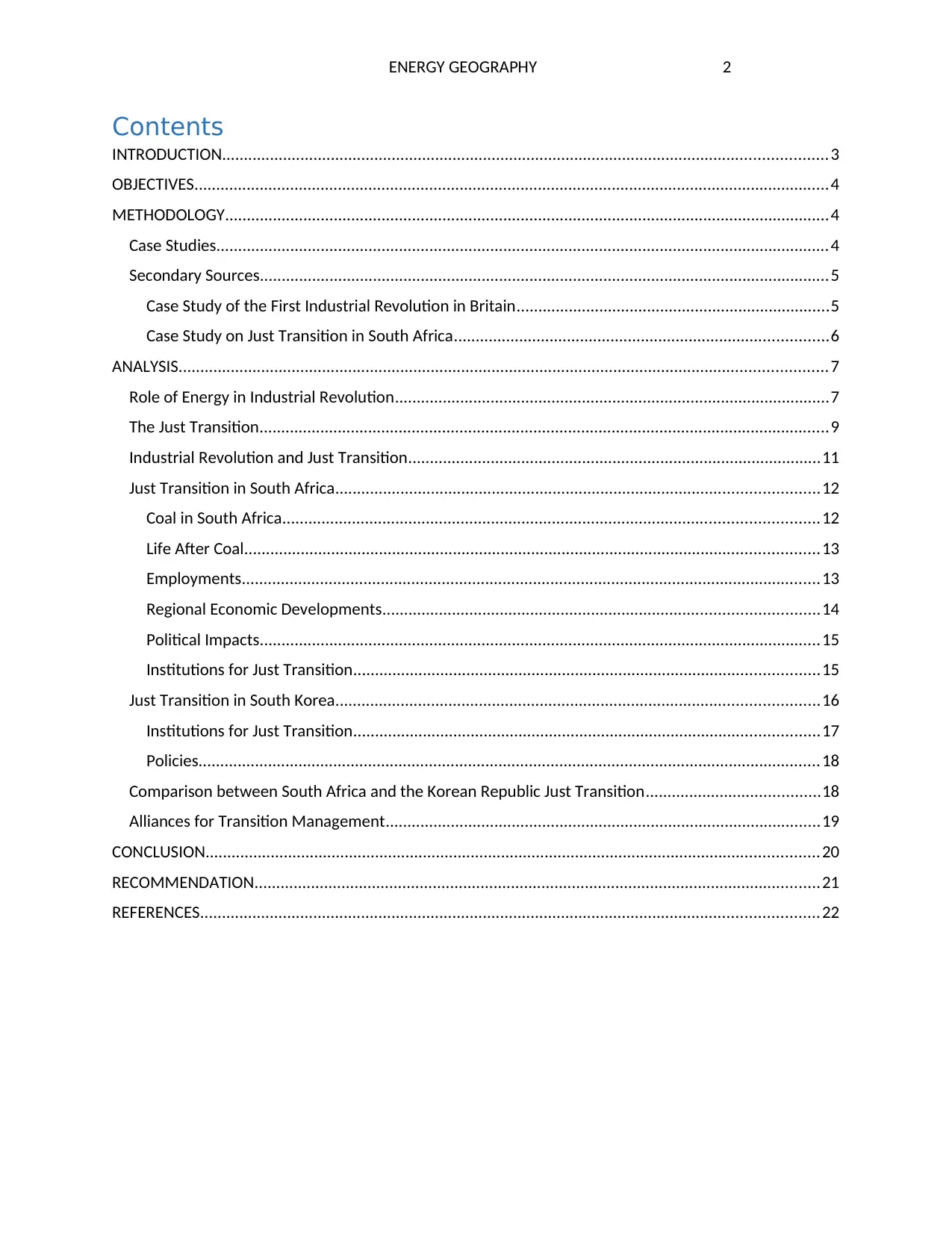
ENERGY GEOGRAPHY 2
Contents
INTRODUCTION...........................................................................................................................................3
OBJECTIVES..................................................................................................................................................4
METHODOLOGY...........................................................................................................................................4
Case Studies.............................................................................................................................................4
Secondary Sources...................................................................................................................................5
Case Study of the First Industrial Revolution in Britain........................................................................5
Case Study on Just Transition in South Africa......................................................................................6
ANALYSIS.....................................................................................................................................................7
Role of Energy in Industrial Revolution....................................................................................................7
The Just Transition...................................................................................................................................9
Industrial Revolution and Just Transition...............................................................................................11
Just Transition in South Africa...............................................................................................................12
Coal in South Africa...........................................................................................................................12
Life After Coal....................................................................................................................................13
Employments.....................................................................................................................................13
Regional Economic Developments....................................................................................................14
Political Impacts.................................................................................................................................15
Institutions for Just Transition...........................................................................................................15
Just Transition in South Korea...............................................................................................................16
Institutions for Just Transition...........................................................................................................17
Policies...............................................................................................................................................18
Comparison between South Africa and the Korean Republic Just Transition........................................18
Alliances for Transition Management....................................................................................................19
CONCLUSION.............................................................................................................................................20
RECOMMENDATION..................................................................................................................................21
REFERENCES..............................................................................................................................................22
Contents
INTRODUCTION...........................................................................................................................................3
OBJECTIVES..................................................................................................................................................4
METHODOLOGY...........................................................................................................................................4
Case Studies.............................................................................................................................................4
Secondary Sources...................................................................................................................................5
Case Study of the First Industrial Revolution in Britain........................................................................5
Case Study on Just Transition in South Africa......................................................................................6
ANALYSIS.....................................................................................................................................................7
Role of Energy in Industrial Revolution....................................................................................................7
The Just Transition...................................................................................................................................9
Industrial Revolution and Just Transition...............................................................................................11
Just Transition in South Africa...............................................................................................................12
Coal in South Africa...........................................................................................................................12
Life After Coal....................................................................................................................................13
Employments.....................................................................................................................................13
Regional Economic Developments....................................................................................................14
Political Impacts.................................................................................................................................15
Institutions for Just Transition...........................................................................................................15
Just Transition in South Korea...............................................................................................................16
Institutions for Just Transition...........................................................................................................17
Policies...............................................................................................................................................18
Comparison between South Africa and the Korean Republic Just Transition........................................18
Alliances for Transition Management....................................................................................................19
CONCLUSION.............................................................................................................................................20
RECOMMENDATION..................................................................................................................................21
REFERENCES..............................................................................................................................................22
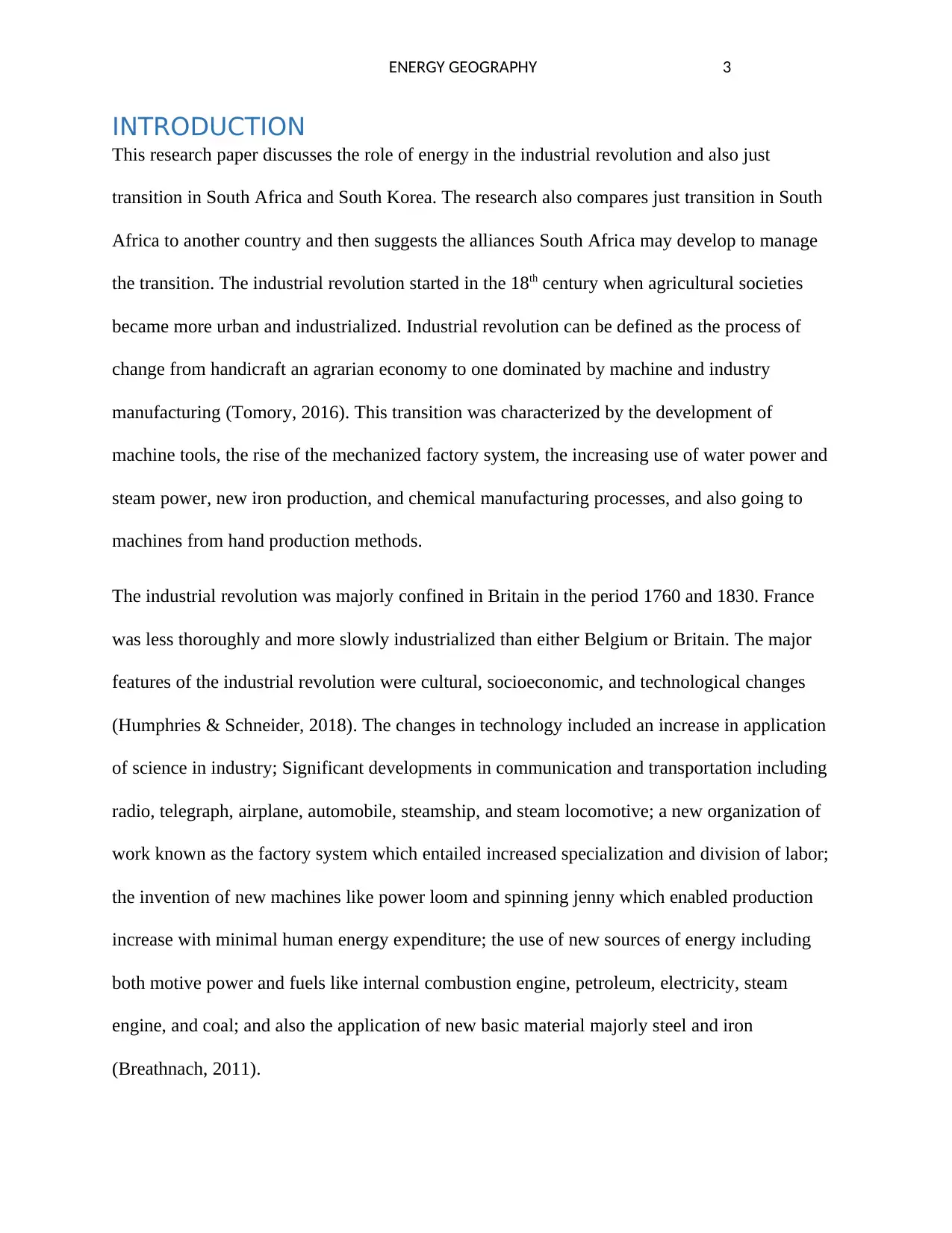
ENERGY GEOGRAPHY 3
INTRODUCTION
This research paper discusses the role of energy in the industrial revolution and also just
transition in South Africa and South Korea. The research also compares just transition in South
Africa to another country and then suggests the alliances South Africa may develop to manage
the transition. The industrial revolution started in the 18th century when agricultural societies
became more urban and industrialized. Industrial revolution can be defined as the process of
change from handicraft an agrarian economy to one dominated by machine and industry
manufacturing (Tomory, 2016). This transition was characterized by the development of
machine tools, the rise of the mechanized factory system, the increasing use of water power and
steam power, new iron production, and chemical manufacturing processes, and also going to
machines from hand production methods.
The industrial revolution was majorly confined in Britain in the period 1760 and 1830. France
was less thoroughly and more slowly industrialized than either Belgium or Britain. The major
features of the industrial revolution were cultural, socioeconomic, and technological changes
(Humphries & Schneider, 2018). The changes in technology included an increase in application
of science in industry; Significant developments in communication and transportation including
radio, telegraph, airplane, automobile, steamship, and steam locomotive; a new organization of
work known as the factory system which entailed increased specialization and division of labor;
the invention of new machines like power loom and spinning jenny which enabled production
increase with minimal human energy expenditure; the use of new sources of energy including
both motive power and fuels like internal combustion engine, petroleum, electricity, steam
engine, and coal; and also the application of new basic material majorly steel and iron
(Breathnach, 2011).
INTRODUCTION
This research paper discusses the role of energy in the industrial revolution and also just
transition in South Africa and South Korea. The research also compares just transition in South
Africa to another country and then suggests the alliances South Africa may develop to manage
the transition. The industrial revolution started in the 18th century when agricultural societies
became more urban and industrialized. Industrial revolution can be defined as the process of
change from handicraft an agrarian economy to one dominated by machine and industry
manufacturing (Tomory, 2016). This transition was characterized by the development of
machine tools, the rise of the mechanized factory system, the increasing use of water power and
steam power, new iron production, and chemical manufacturing processes, and also going to
machines from hand production methods.
The industrial revolution was majorly confined in Britain in the period 1760 and 1830. France
was less thoroughly and more slowly industrialized than either Belgium or Britain. The major
features of the industrial revolution were cultural, socioeconomic, and technological changes
(Humphries & Schneider, 2018). The changes in technology included an increase in application
of science in industry; Significant developments in communication and transportation including
radio, telegraph, airplane, automobile, steamship, and steam locomotive; a new organization of
work known as the factory system which entailed increased specialization and division of labor;
the invention of new machines like power loom and spinning jenny which enabled production
increase with minimal human energy expenditure; the use of new sources of energy including
both motive power and fuels like internal combustion engine, petroleum, electricity, steam
engine, and coal; and also the application of new basic material majorly steel and iron
(Breathnach, 2011).
⊘ This is a preview!⊘
Do you want full access?
Subscribe today to unlock all pages.

Trusted by 1+ million students worldwide
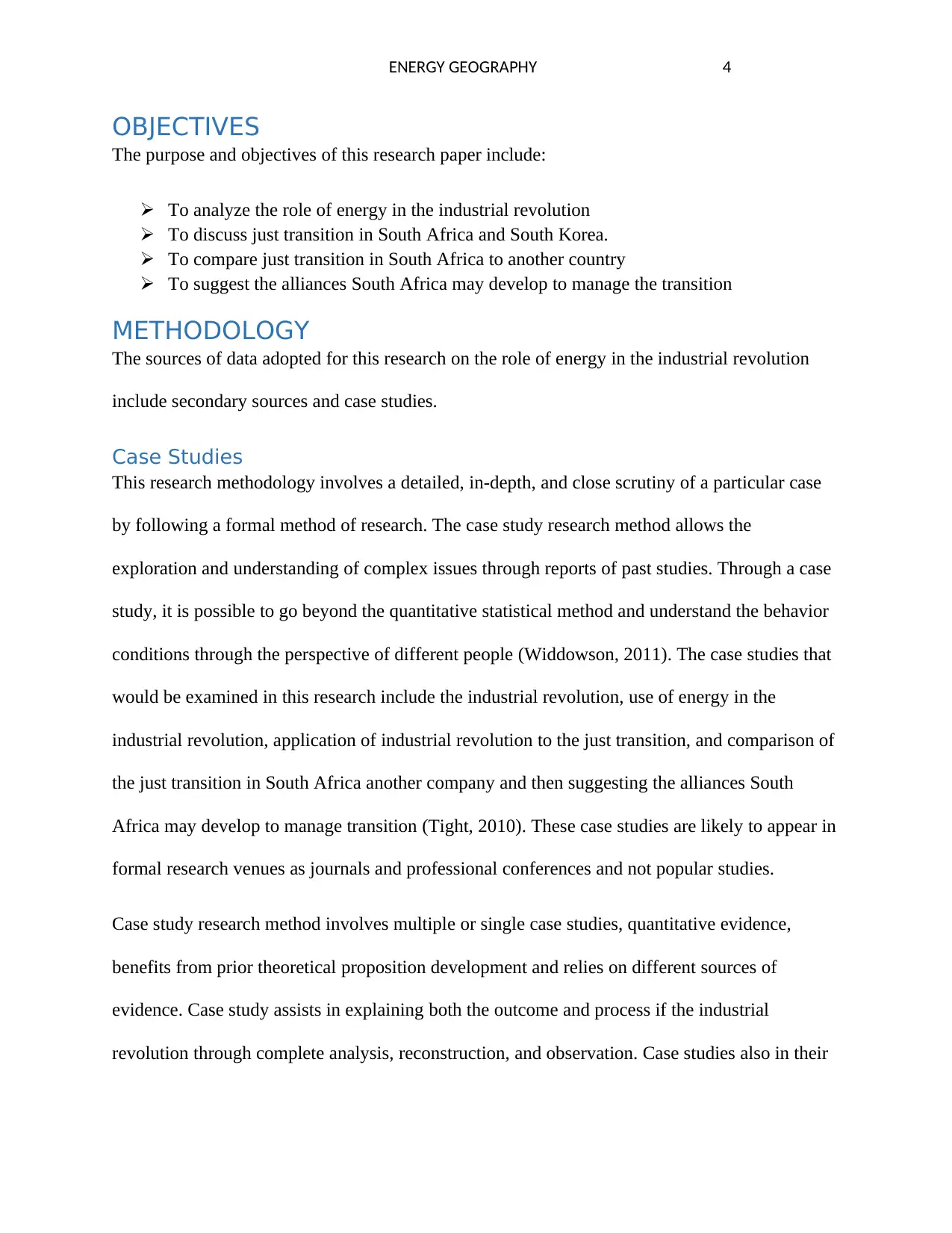
ENERGY GEOGRAPHY 4
OBJECTIVES
The purpose and objectives of this research paper include:
To analyze the role of energy in the industrial revolution
To discuss just transition in South Africa and South Korea.
To compare just transition in South Africa to another country
To suggest the alliances South Africa may develop to manage the transition
METHODOLOGY
The sources of data adopted for this research on the role of energy in the industrial revolution
include secondary sources and case studies.
Case Studies
This research methodology involves a detailed, in-depth, and close scrutiny of a particular case
by following a formal method of research. The case study research method allows the
exploration and understanding of complex issues through reports of past studies. Through a case
study, it is possible to go beyond the quantitative statistical method and understand the behavior
conditions through the perspective of different people (Widdowson, 2011). The case studies that
would be examined in this research include the industrial revolution, use of energy in the
industrial revolution, application of industrial revolution to the just transition, and comparison of
the just transition in South Africa another company and then suggesting the alliances South
Africa may develop to manage transition (Tight, 2010). These case studies are likely to appear in
formal research venues as journals and professional conferences and not popular studies.
Case study research method involves multiple or single case studies, quantitative evidence,
benefits from prior theoretical proposition development and relies on different sources of
evidence. Case study assists in explaining both the outcome and process if the industrial
revolution through complete analysis, reconstruction, and observation. Case studies also in their
OBJECTIVES
The purpose and objectives of this research paper include:
To analyze the role of energy in the industrial revolution
To discuss just transition in South Africa and South Korea.
To compare just transition in South Africa to another country
To suggest the alliances South Africa may develop to manage the transition
METHODOLOGY
The sources of data adopted for this research on the role of energy in the industrial revolution
include secondary sources and case studies.
Case Studies
This research methodology involves a detailed, in-depth, and close scrutiny of a particular case
by following a formal method of research. The case study research method allows the
exploration and understanding of complex issues through reports of past studies. Through a case
study, it is possible to go beyond the quantitative statistical method and understand the behavior
conditions through the perspective of different people (Widdowson, 2011). The case studies that
would be examined in this research include the industrial revolution, use of energy in the
industrial revolution, application of industrial revolution to the just transition, and comparison of
the just transition in South Africa another company and then suggesting the alliances South
Africa may develop to manage transition (Tight, 2010). These case studies are likely to appear in
formal research venues as journals and professional conferences and not popular studies.
Case study research method involves multiple or single case studies, quantitative evidence,
benefits from prior theoretical proposition development and relies on different sources of
evidence. Case study assists in explaining both the outcome and process if the industrial
revolution through complete analysis, reconstruction, and observation. Case studies also in their
Paraphrase This Document
Need a fresh take? Get an instant paraphrase of this document with our AI Paraphraser
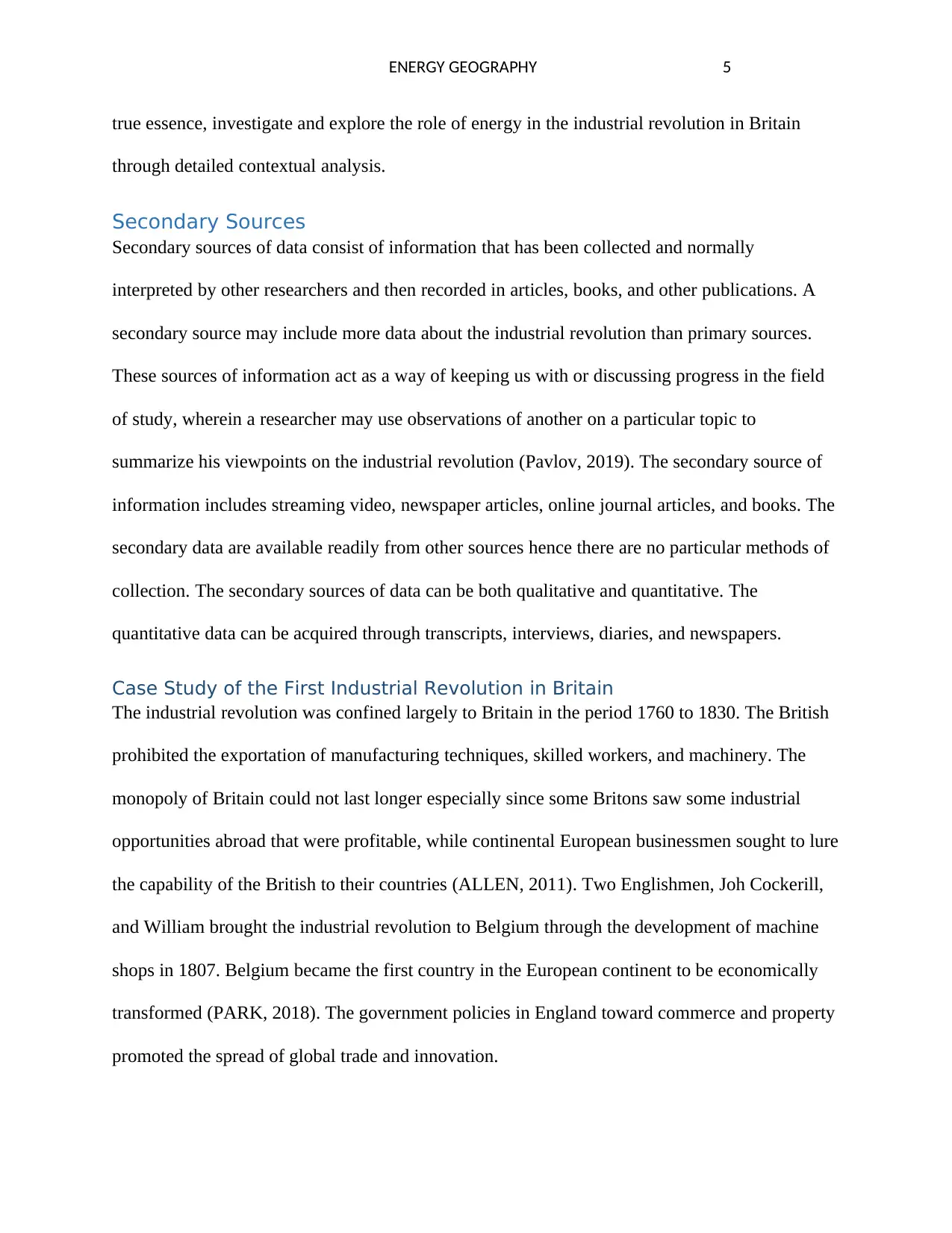
ENERGY GEOGRAPHY 5
true essence, investigate and explore the role of energy in the industrial revolution in Britain
through detailed contextual analysis.
Secondary Sources
Secondary sources of data consist of information that has been collected and normally
interpreted by other researchers and then recorded in articles, books, and other publications. A
secondary source may include more data about the industrial revolution than primary sources.
These sources of information act as a way of keeping us with or discussing progress in the field
of study, wherein a researcher may use observations of another on a particular topic to
summarize his viewpoints on the industrial revolution (Pavlov, 2019). The secondary source of
information includes streaming video, newspaper articles, online journal articles, and books. The
secondary data are available readily from other sources hence there are no particular methods of
collection. The secondary sources of data can be both qualitative and quantitative. The
quantitative data can be acquired through transcripts, interviews, diaries, and newspapers.
Case Study of the First Industrial Revolution in Britain
The industrial revolution was confined largely to Britain in the period 1760 to 1830. The British
prohibited the exportation of manufacturing techniques, skilled workers, and machinery. The
monopoly of Britain could not last longer especially since some Britons saw some industrial
opportunities abroad that were profitable, while continental European businessmen sought to lure
the capability of the British to their countries (ALLEN, 2011). Two Englishmen, Joh Cockerill,
and William brought the industrial revolution to Belgium through the development of machine
shops in 1807. Belgium became the first country in the European continent to be economically
transformed (PARK, 2018). The government policies in England toward commerce and property
promoted the spread of global trade and innovation.
true essence, investigate and explore the role of energy in the industrial revolution in Britain
through detailed contextual analysis.
Secondary Sources
Secondary sources of data consist of information that has been collected and normally
interpreted by other researchers and then recorded in articles, books, and other publications. A
secondary source may include more data about the industrial revolution than primary sources.
These sources of information act as a way of keeping us with or discussing progress in the field
of study, wherein a researcher may use observations of another on a particular topic to
summarize his viewpoints on the industrial revolution (Pavlov, 2019). The secondary source of
information includes streaming video, newspaper articles, online journal articles, and books. The
secondary data are available readily from other sources hence there are no particular methods of
collection. The secondary sources of data can be both qualitative and quantitative. The
quantitative data can be acquired through transcripts, interviews, diaries, and newspapers.
Case Study of the First Industrial Revolution in Britain
The industrial revolution was confined largely to Britain in the period 1760 to 1830. The British
prohibited the exportation of manufacturing techniques, skilled workers, and machinery. The
monopoly of Britain could not last longer especially since some Britons saw some industrial
opportunities abroad that were profitable, while continental European businessmen sought to lure
the capability of the British to their countries (ALLEN, 2011). Two Englishmen, Joh Cockerill,
and William brought the industrial revolution to Belgium through the development of machine
shops in 1807. Belgium became the first country in the European continent to be economically
transformed (PARK, 2018). The government policies in England toward commerce and property
promoted the spread of global trade and innovation.
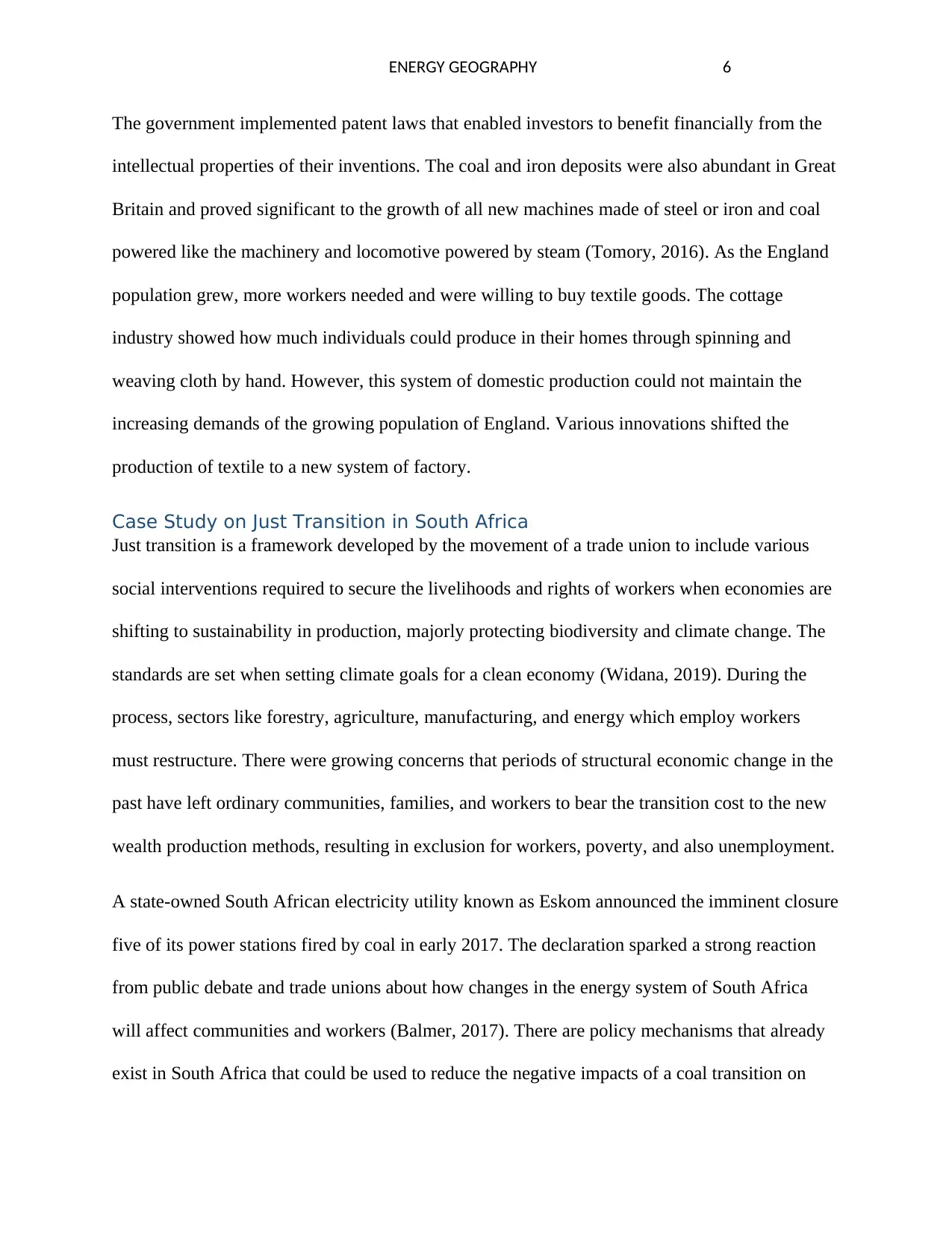
ENERGY GEOGRAPHY 6
The government implemented patent laws that enabled investors to benefit financially from the
intellectual properties of their inventions. The coal and iron deposits were also abundant in Great
Britain and proved significant to the growth of all new machines made of steel or iron and coal
powered like the machinery and locomotive powered by steam (Tomory, 2016). As the England
population grew, more workers needed and were willing to buy textile goods. The cottage
industry showed how much individuals could produce in their homes through spinning and
weaving cloth by hand. However, this system of domestic production could not maintain the
increasing demands of the growing population of England. Various innovations shifted the
production of textile to a new system of factory.
Case Study on Just Transition in South Africa
Just transition is a framework developed by the movement of a trade union to include various
social interventions required to secure the livelihoods and rights of workers when economies are
shifting to sustainability in production, majorly protecting biodiversity and climate change. The
standards are set when setting climate goals for a clean economy (Widana, 2019). During the
process, sectors like forestry, agriculture, manufacturing, and energy which employ workers
must restructure. There were growing concerns that periods of structural economic change in the
past have left ordinary communities, families, and workers to bear the transition cost to the new
wealth production methods, resulting in exclusion for workers, poverty, and also unemployment.
A state-owned South African electricity utility known as Eskom announced the imminent closure
five of its power stations fired by coal in early 2017. The declaration sparked a strong reaction
from public debate and trade unions about how changes in the energy system of South Africa
will affect communities and workers (Balmer, 2017). There are policy mechanisms that already
exist in South Africa that could be used to reduce the negative impacts of a coal transition on
The government implemented patent laws that enabled investors to benefit financially from the
intellectual properties of their inventions. The coal and iron deposits were also abundant in Great
Britain and proved significant to the growth of all new machines made of steel or iron and coal
powered like the machinery and locomotive powered by steam (Tomory, 2016). As the England
population grew, more workers needed and were willing to buy textile goods. The cottage
industry showed how much individuals could produce in their homes through spinning and
weaving cloth by hand. However, this system of domestic production could not maintain the
increasing demands of the growing population of England. Various innovations shifted the
production of textile to a new system of factory.
Case Study on Just Transition in South Africa
Just transition is a framework developed by the movement of a trade union to include various
social interventions required to secure the livelihoods and rights of workers when economies are
shifting to sustainability in production, majorly protecting biodiversity and climate change. The
standards are set when setting climate goals for a clean economy (Widana, 2019). During the
process, sectors like forestry, agriculture, manufacturing, and energy which employ workers
must restructure. There were growing concerns that periods of structural economic change in the
past have left ordinary communities, families, and workers to bear the transition cost to the new
wealth production methods, resulting in exclusion for workers, poverty, and also unemployment.
A state-owned South African electricity utility known as Eskom announced the imminent closure
five of its power stations fired by coal in early 2017. The declaration sparked a strong reaction
from public debate and trade unions about how changes in the energy system of South Africa
will affect communities and workers (Balmer, 2017). There are policy mechanisms that already
exist in South Africa that could be used to reduce the negative impacts of a coal transition on
⊘ This is a preview!⊘
Do you want full access?
Subscribe today to unlock all pages.

Trusted by 1+ million students worldwide
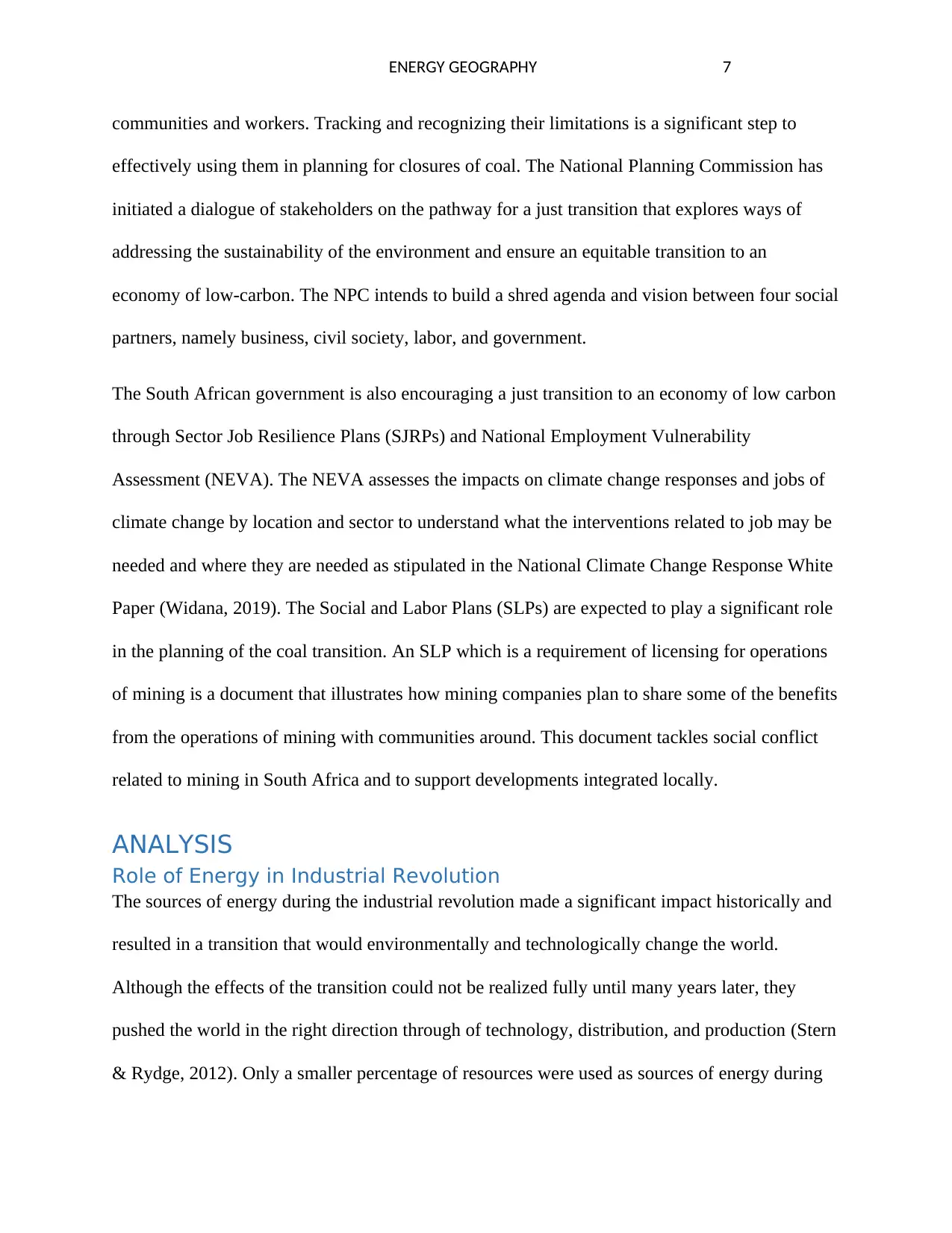
ENERGY GEOGRAPHY 7
communities and workers. Tracking and recognizing their limitations is a significant step to
effectively using them in planning for closures of coal. The National Planning Commission has
initiated a dialogue of stakeholders on the pathway for a just transition that explores ways of
addressing the sustainability of the environment and ensure an equitable transition to an
economy of low-carbon. The NPC intends to build a shred agenda and vision between four social
partners, namely business, civil society, labor, and government.
The South African government is also encouraging a just transition to an economy of low carbon
through Sector Job Resilience Plans (SJRPs) and National Employment Vulnerability
Assessment (NEVA). The NEVA assesses the impacts on climate change responses and jobs of
climate change by location and sector to understand what the interventions related to job may be
needed and where they are needed as stipulated in the National Climate Change Response White
Paper (Widana, 2019). The Social and Labor Plans (SLPs) are expected to play a significant role
in the planning of the coal transition. An SLP which is a requirement of licensing for operations
of mining is a document that illustrates how mining companies plan to share some of the benefits
from the operations of mining with communities around. This document tackles social conflict
related to mining in South Africa and to support developments integrated locally.
ANALYSIS
Role of Energy in Industrial Revolution
The sources of energy during the industrial revolution made a significant impact historically and
resulted in a transition that would environmentally and technologically change the world.
Although the effects of the transition could not be realized fully until many years later, they
pushed the world in the right direction through of technology, distribution, and production (Stern
& Rydge, 2012). Only a smaller percentage of resources were used as sources of energy during
communities and workers. Tracking and recognizing their limitations is a significant step to
effectively using them in planning for closures of coal. The National Planning Commission has
initiated a dialogue of stakeholders on the pathway for a just transition that explores ways of
addressing the sustainability of the environment and ensure an equitable transition to an
economy of low-carbon. The NPC intends to build a shred agenda and vision between four social
partners, namely business, civil society, labor, and government.
The South African government is also encouraging a just transition to an economy of low carbon
through Sector Job Resilience Plans (SJRPs) and National Employment Vulnerability
Assessment (NEVA). The NEVA assesses the impacts on climate change responses and jobs of
climate change by location and sector to understand what the interventions related to job may be
needed and where they are needed as stipulated in the National Climate Change Response White
Paper (Widana, 2019). The Social and Labor Plans (SLPs) are expected to play a significant role
in the planning of the coal transition. An SLP which is a requirement of licensing for operations
of mining is a document that illustrates how mining companies plan to share some of the benefits
from the operations of mining with communities around. This document tackles social conflict
related to mining in South Africa and to support developments integrated locally.
ANALYSIS
Role of Energy in Industrial Revolution
The sources of energy during the industrial revolution made a significant impact historically and
resulted in a transition that would environmentally and technologically change the world.
Although the effects of the transition could not be realized fully until many years later, they
pushed the world in the right direction through of technology, distribution, and production (Stern
& Rydge, 2012). Only a smaller percentage of resources were used as sources of energy during
Paraphrase This Document
Need a fresh take? Get an instant paraphrase of this document with our AI Paraphraser
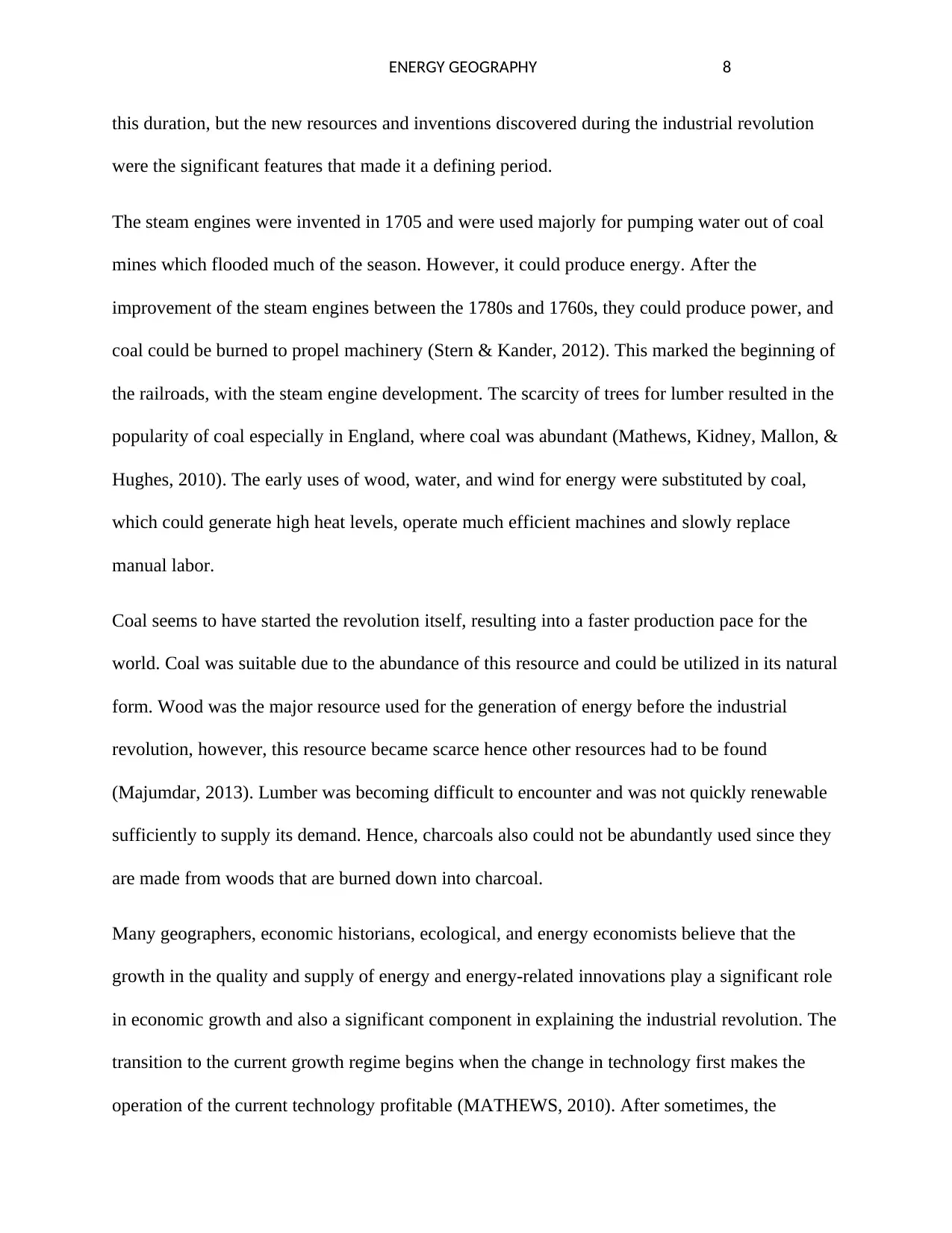
ENERGY GEOGRAPHY 8
this duration, but the new resources and inventions discovered during the industrial revolution
were the significant features that made it a defining period.
The steam engines were invented in 1705 and were used majorly for pumping water out of coal
mines which flooded much of the season. However, it could produce energy. After the
improvement of the steam engines between the 1780s and 1760s, they could produce power, and
coal could be burned to propel machinery (Stern & Kander, 2012). This marked the beginning of
the railroads, with the steam engine development. The scarcity of trees for lumber resulted in the
popularity of coal especially in England, where coal was abundant (Mathews, Kidney, Mallon, &
Hughes, 2010). The early uses of wood, water, and wind for energy were substituted by coal,
which could generate high heat levels, operate much efficient machines and slowly replace
manual labor.
Coal seems to have started the revolution itself, resulting into a faster production pace for the
world. Coal was suitable due to the abundance of this resource and could be utilized in its natural
form. Wood was the major resource used for the generation of energy before the industrial
revolution, however, this resource became scarce hence other resources had to be found
(Majumdar, 2013). Lumber was becoming difficult to encounter and was not quickly renewable
sufficiently to supply its demand. Hence, charcoals also could not be abundantly used since they
are made from woods that are burned down into charcoal.
Many geographers, economic historians, ecological, and energy economists believe that the
growth in the quality and supply of energy and energy-related innovations play a significant role
in economic growth and also a significant component in explaining the industrial revolution. The
transition to the current growth regime begins when the change in technology first makes the
operation of the current technology profitable (MATHEWS, 2010). After sometimes, the
this duration, but the new resources and inventions discovered during the industrial revolution
were the significant features that made it a defining period.
The steam engines were invented in 1705 and were used majorly for pumping water out of coal
mines which flooded much of the season. However, it could produce energy. After the
improvement of the steam engines between the 1780s and 1760s, they could produce power, and
coal could be burned to propel machinery (Stern & Kander, 2012). This marked the beginning of
the railroads, with the steam engine development. The scarcity of trees for lumber resulted in the
popularity of coal especially in England, where coal was abundant (Mathews, Kidney, Mallon, &
Hughes, 2010). The early uses of wood, water, and wind for energy were substituted by coal,
which could generate high heat levels, operate much efficient machines and slowly replace
manual labor.
Coal seems to have started the revolution itself, resulting into a faster production pace for the
world. Coal was suitable due to the abundance of this resource and could be utilized in its natural
form. Wood was the major resource used for the generation of energy before the industrial
revolution, however, this resource became scarce hence other resources had to be found
(Majumdar, 2013). Lumber was becoming difficult to encounter and was not quickly renewable
sufficiently to supply its demand. Hence, charcoals also could not be abundantly used since they
are made from woods that are burned down into charcoal.
Many geographers, economic historians, ecological, and energy economists believe that the
growth in the quality and supply of energy and energy-related innovations play a significant role
in economic growth and also a significant component in explaining the industrial revolution. The
transition to the current growth regime begins when the change in technology first makes the
operation of the current technology profitable (MATHEWS, 2010). After sometimes, the
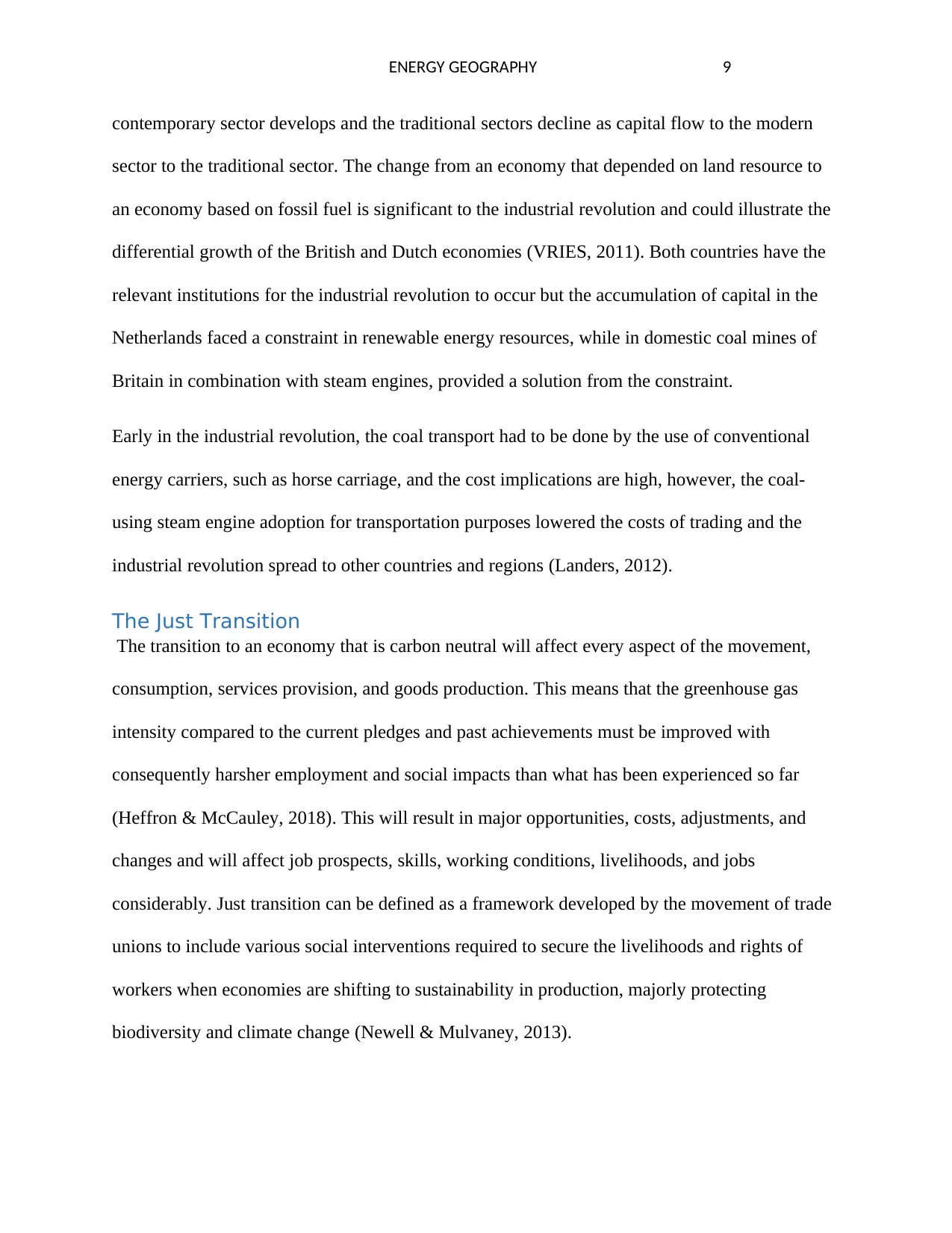
ENERGY GEOGRAPHY 9
contemporary sector develops and the traditional sectors decline as capital flow to the modern
sector to the traditional sector. The change from an economy that depended on land resource to
an economy based on fossil fuel is significant to the industrial revolution and could illustrate the
differential growth of the British and Dutch economies (VRIES, 2011). Both countries have the
relevant institutions for the industrial revolution to occur but the accumulation of capital in the
Netherlands faced a constraint in renewable energy resources, while in domestic coal mines of
Britain in combination with steam engines, provided a solution from the constraint.
Early in the industrial revolution, the coal transport had to be done by the use of conventional
energy carriers, such as horse carriage, and the cost implications are high, however, the coal-
using steam engine adoption for transportation purposes lowered the costs of trading and the
industrial revolution spread to other countries and regions (Landers, 2012).
The Just Transition
The transition to an economy that is carbon neutral will affect every aspect of the movement,
consumption, services provision, and goods production. This means that the greenhouse gas
intensity compared to the current pledges and past achievements must be improved with
consequently harsher employment and social impacts than what has been experienced so far
(Heffron & McCauley, 2018). This will result in major opportunities, costs, adjustments, and
changes and will affect job prospects, skills, working conditions, livelihoods, and jobs
considerably. Just transition can be defined as a framework developed by the movement of trade
unions to include various social interventions required to secure the livelihoods and rights of
workers when economies are shifting to sustainability in production, majorly protecting
biodiversity and climate change (Newell & Mulvaney, 2013).
contemporary sector develops and the traditional sectors decline as capital flow to the modern
sector to the traditional sector. The change from an economy that depended on land resource to
an economy based on fossil fuel is significant to the industrial revolution and could illustrate the
differential growth of the British and Dutch economies (VRIES, 2011). Both countries have the
relevant institutions for the industrial revolution to occur but the accumulation of capital in the
Netherlands faced a constraint in renewable energy resources, while in domestic coal mines of
Britain in combination with steam engines, provided a solution from the constraint.
Early in the industrial revolution, the coal transport had to be done by the use of conventional
energy carriers, such as horse carriage, and the cost implications are high, however, the coal-
using steam engine adoption for transportation purposes lowered the costs of trading and the
industrial revolution spread to other countries and regions (Landers, 2012).
The Just Transition
The transition to an economy that is carbon neutral will affect every aspect of the movement,
consumption, services provision, and goods production. This means that the greenhouse gas
intensity compared to the current pledges and past achievements must be improved with
consequently harsher employment and social impacts than what has been experienced so far
(Heffron & McCauley, 2018). This will result in major opportunities, costs, adjustments, and
changes and will affect job prospects, skills, working conditions, livelihoods, and jobs
considerably. Just transition can be defined as a framework developed by the movement of trade
unions to include various social interventions required to secure the livelihoods and rights of
workers when economies are shifting to sustainability in production, majorly protecting
biodiversity and climate change (Newell & Mulvaney, 2013).
⊘ This is a preview!⊘
Do you want full access?
Subscribe today to unlock all pages.

Trusted by 1+ million students worldwide
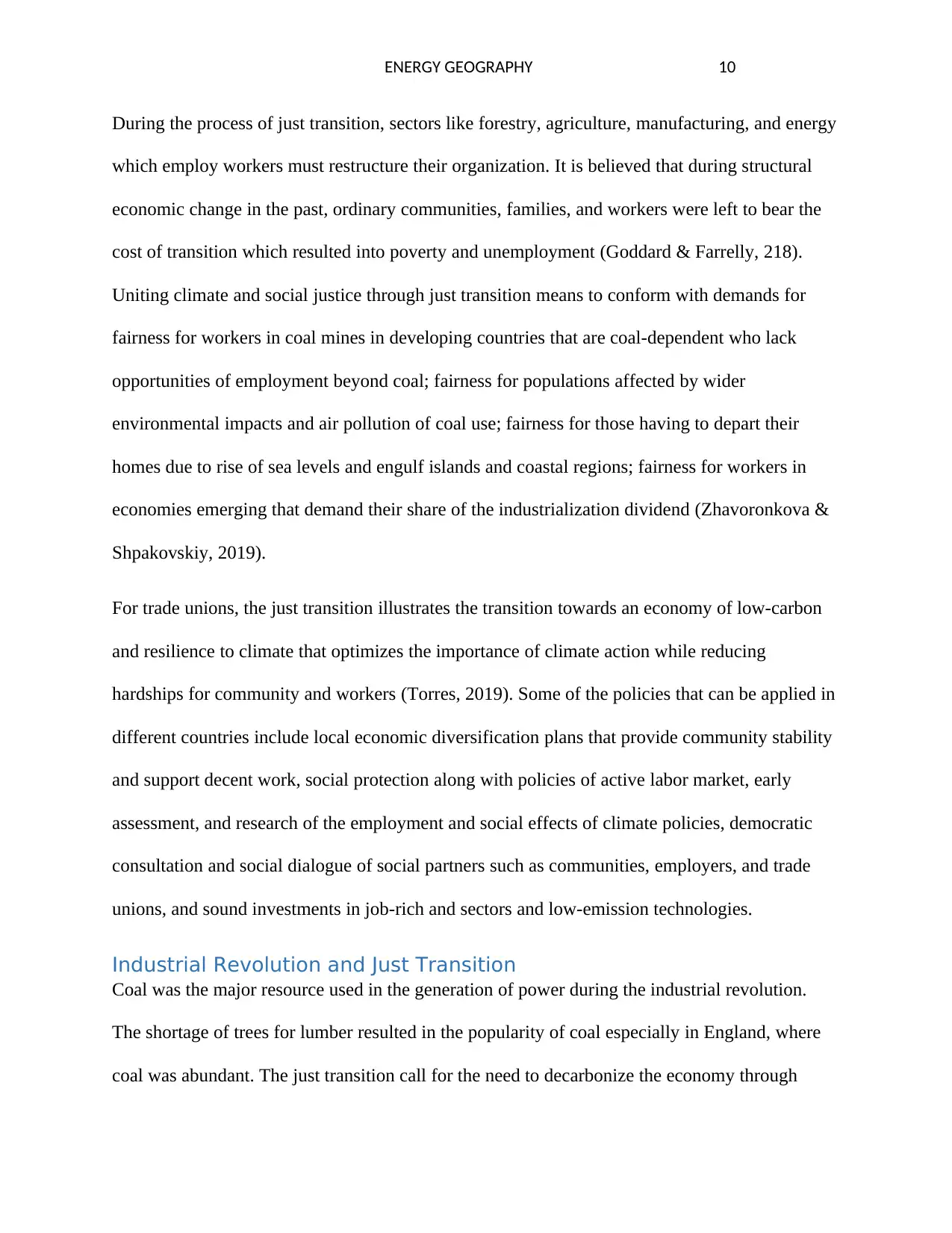
ENERGY GEOGRAPHY 10
During the process of just transition, sectors like forestry, agriculture, manufacturing, and energy
which employ workers must restructure their organization. It is believed that during structural
economic change in the past, ordinary communities, families, and workers were left to bear the
cost of transition which resulted into poverty and unemployment (Goddard & Farrelly, 218).
Uniting climate and social justice through just transition means to conform with demands for
fairness for workers in coal mines in developing countries that are coal-dependent who lack
opportunities of employment beyond coal; fairness for populations affected by wider
environmental impacts and air pollution of coal use; fairness for those having to depart their
homes due to rise of sea levels and engulf islands and coastal regions; fairness for workers in
economies emerging that demand their share of the industrialization dividend (Zhavoronkova &
Shpakovskiy, 2019).
For trade unions, the just transition illustrates the transition towards an economy of low-carbon
and resilience to climate that optimizes the importance of climate action while reducing
hardships for community and workers (Torres, 2019). Some of the policies that can be applied in
different countries include local economic diversification plans that provide community stability
and support decent work, social protection along with policies of active labor market, early
assessment, and research of the employment and social effects of climate policies, democratic
consultation and social dialogue of social partners such as communities, employers, and trade
unions, and sound investments in job-rich and sectors and low-emission technologies.
Industrial Revolution and Just Transition
Coal was the major resource used in the generation of power during the industrial revolution.
The shortage of trees for lumber resulted in the popularity of coal especially in England, where
coal was abundant. The just transition call for the need to decarbonize the economy through
During the process of just transition, sectors like forestry, agriculture, manufacturing, and energy
which employ workers must restructure their organization. It is believed that during structural
economic change in the past, ordinary communities, families, and workers were left to bear the
cost of transition which resulted into poverty and unemployment (Goddard & Farrelly, 218).
Uniting climate and social justice through just transition means to conform with demands for
fairness for workers in coal mines in developing countries that are coal-dependent who lack
opportunities of employment beyond coal; fairness for populations affected by wider
environmental impacts and air pollution of coal use; fairness for those having to depart their
homes due to rise of sea levels and engulf islands and coastal regions; fairness for workers in
economies emerging that demand their share of the industrialization dividend (Zhavoronkova &
Shpakovskiy, 2019).
For trade unions, the just transition illustrates the transition towards an economy of low-carbon
and resilience to climate that optimizes the importance of climate action while reducing
hardships for community and workers (Torres, 2019). Some of the policies that can be applied in
different countries include local economic diversification plans that provide community stability
and support decent work, social protection along with policies of active labor market, early
assessment, and research of the employment and social effects of climate policies, democratic
consultation and social dialogue of social partners such as communities, employers, and trade
unions, and sound investments in job-rich and sectors and low-emission technologies.
Industrial Revolution and Just Transition
Coal was the major resource used in the generation of power during the industrial revolution.
The shortage of trees for lumber resulted in the popularity of coal especially in England, where
coal was abundant. The just transition call for the need to decarbonize the economy through
Paraphrase This Document
Need a fresh take? Get an instant paraphrase of this document with our AI Paraphraser
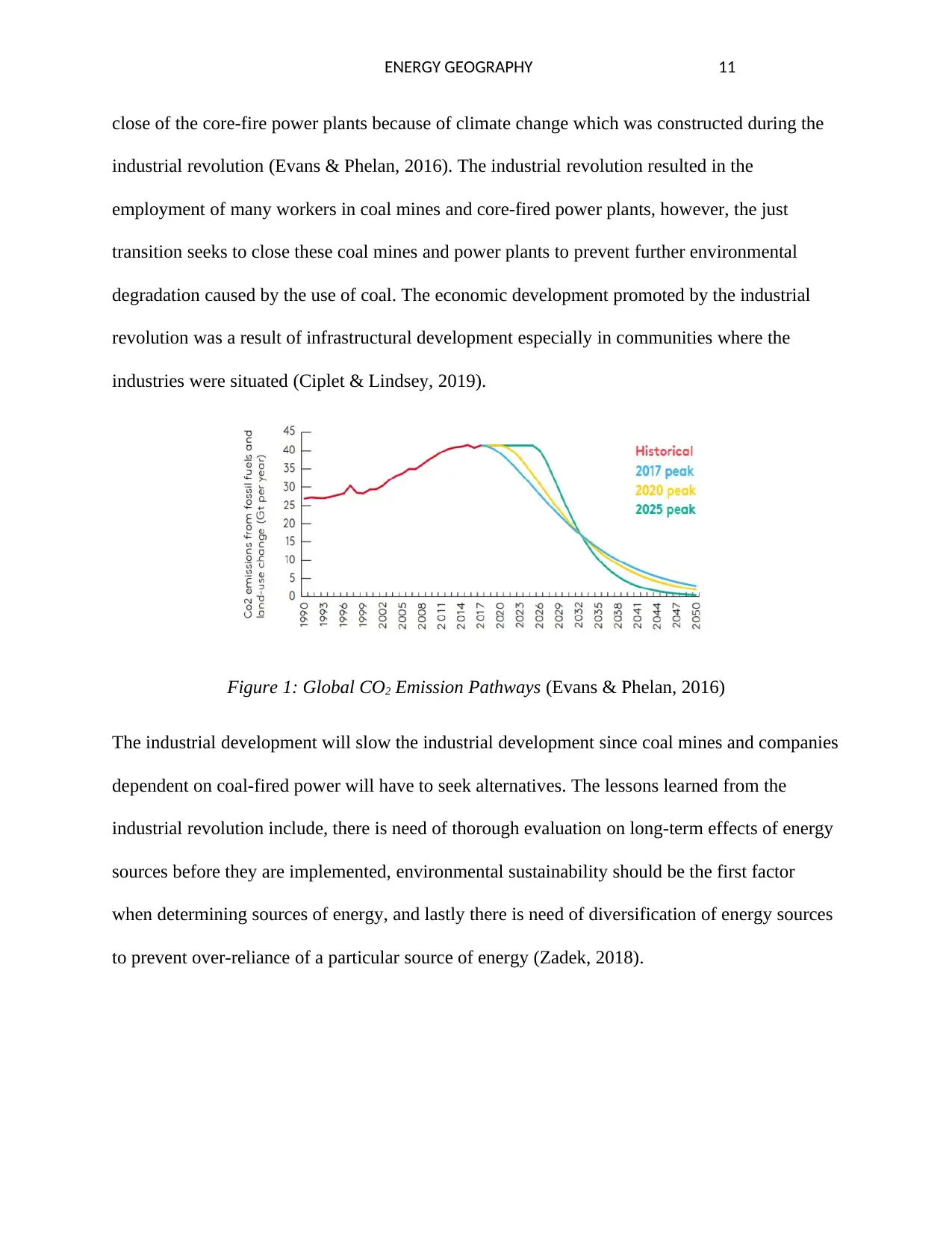
ENERGY GEOGRAPHY 11
close of the core-fire power plants because of climate change which was constructed during the
industrial revolution (Evans & Phelan, 2016). The industrial revolution resulted in the
employment of many workers in coal mines and core-fired power plants, however, the just
transition seeks to close these coal mines and power plants to prevent further environmental
degradation caused by the use of coal. The economic development promoted by the industrial
revolution was a result of infrastructural development especially in communities where the
industries were situated (Ciplet & Lindsey, 2019).
Figure 1: Global CO2 Emission Pathways (Evans & Phelan, 2016)
The industrial development will slow the industrial development since coal mines and companies
dependent on coal-fired power will have to seek alternatives. The lessons learned from the
industrial revolution include, there is need of thorough evaluation on long-term effects of energy
sources before they are implemented, environmental sustainability should be the first factor
when determining sources of energy, and lastly there is need of diversification of energy sources
to prevent over-reliance of a particular source of energy (Zadek, 2018).
close of the core-fire power plants because of climate change which was constructed during the
industrial revolution (Evans & Phelan, 2016). The industrial revolution resulted in the
employment of many workers in coal mines and core-fired power plants, however, the just
transition seeks to close these coal mines and power plants to prevent further environmental
degradation caused by the use of coal. The economic development promoted by the industrial
revolution was a result of infrastructural development especially in communities where the
industries were situated (Ciplet & Lindsey, 2019).
Figure 1: Global CO2 Emission Pathways (Evans & Phelan, 2016)
The industrial development will slow the industrial development since coal mines and companies
dependent on coal-fired power will have to seek alternatives. The lessons learned from the
industrial revolution include, there is need of thorough evaluation on long-term effects of energy
sources before they are implemented, environmental sustainability should be the first factor
when determining sources of energy, and lastly there is need of diversification of energy sources
to prevent over-reliance of a particular source of energy (Zadek, 2018).
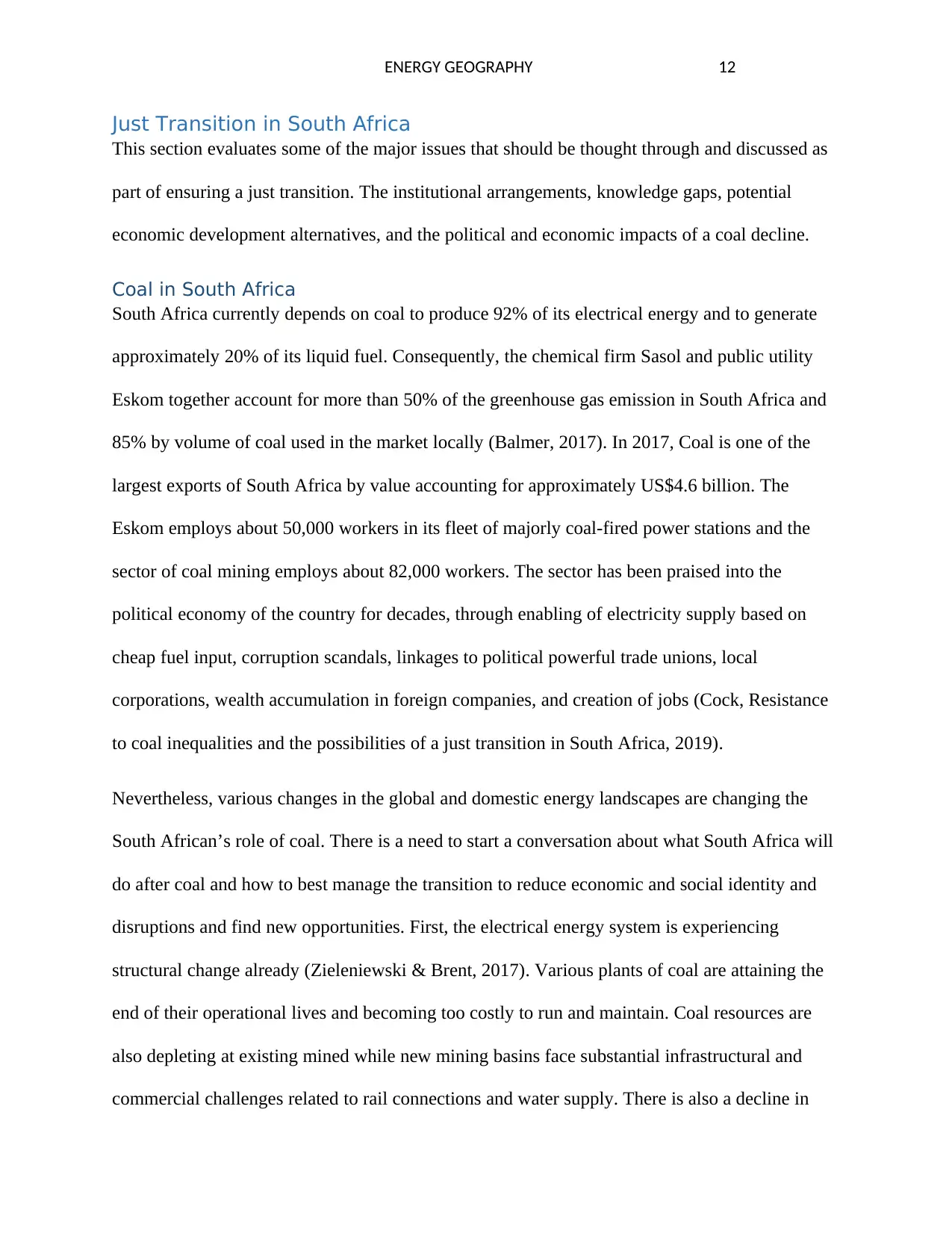
ENERGY GEOGRAPHY 12
Just Transition in South Africa
This section evaluates some of the major issues that should be thought through and discussed as
part of ensuring a just transition. The institutional arrangements, knowledge gaps, potential
economic development alternatives, and the political and economic impacts of a coal decline.
Coal in South Africa
South Africa currently depends on coal to produce 92% of its electrical energy and to generate
approximately 20% of its liquid fuel. Consequently, the chemical firm Sasol and public utility
Eskom together account for more than 50% of the greenhouse gas emission in South Africa and
85% by volume of coal used in the market locally (Balmer, 2017). In 2017, Coal is one of the
largest exports of South Africa by value accounting for approximately US$4.6 billion. The
Eskom employs about 50,000 workers in its fleet of majorly coal-fired power stations and the
sector of coal mining employs about 82,000 workers. The sector has been praised into the
political economy of the country for decades, through enabling of electricity supply based on
cheap fuel input, corruption scandals, linkages to political powerful trade unions, local
corporations, wealth accumulation in foreign companies, and creation of jobs (Cock, Resistance
to coal inequalities and the possibilities of a just transition in South Africa, 2019).
Nevertheless, various changes in the global and domestic energy landscapes are changing the
South African’s role of coal. There is a need to start a conversation about what South Africa will
do after coal and how to best manage the transition to reduce economic and social identity and
disruptions and find new opportunities. First, the electrical energy system is experiencing
structural change already (Zieleniewski & Brent, 2017). Various plants of coal are attaining the
end of their operational lives and becoming too costly to run and maintain. Coal resources are
also depleting at existing mined while new mining basins face substantial infrastructural and
commercial challenges related to rail connections and water supply. There is also a decline in
Just Transition in South Africa
This section evaluates some of the major issues that should be thought through and discussed as
part of ensuring a just transition. The institutional arrangements, knowledge gaps, potential
economic development alternatives, and the political and economic impacts of a coal decline.
Coal in South Africa
South Africa currently depends on coal to produce 92% of its electrical energy and to generate
approximately 20% of its liquid fuel. Consequently, the chemical firm Sasol and public utility
Eskom together account for more than 50% of the greenhouse gas emission in South Africa and
85% by volume of coal used in the market locally (Balmer, 2017). In 2017, Coal is one of the
largest exports of South Africa by value accounting for approximately US$4.6 billion. The
Eskom employs about 50,000 workers in its fleet of majorly coal-fired power stations and the
sector of coal mining employs about 82,000 workers. The sector has been praised into the
political economy of the country for decades, through enabling of electricity supply based on
cheap fuel input, corruption scandals, linkages to political powerful trade unions, local
corporations, wealth accumulation in foreign companies, and creation of jobs (Cock, Resistance
to coal inequalities and the possibilities of a just transition in South Africa, 2019).
Nevertheless, various changes in the global and domestic energy landscapes are changing the
South African’s role of coal. There is a need to start a conversation about what South Africa will
do after coal and how to best manage the transition to reduce economic and social identity and
disruptions and find new opportunities. First, the electrical energy system is experiencing
structural change already (Zieleniewski & Brent, 2017). Various plants of coal are attaining the
end of their operational lives and becoming too costly to run and maintain. Coal resources are
also depleting at existing mined while new mining basins face substantial infrastructural and
commercial challenges related to rail connections and water supply. There is also a decline in
⊘ This is a preview!⊘
Do you want full access?
Subscribe today to unlock all pages.

Trusted by 1+ million students worldwide
1 out of 24
Related Documents
Your All-in-One AI-Powered Toolkit for Academic Success.
+13062052269
info@desklib.com
Available 24*7 on WhatsApp / Email
![[object Object]](/_next/static/media/star-bottom.7253800d.svg)
Unlock your academic potential
Copyright © 2020–2025 A2Z Services. All Rights Reserved. Developed and managed by ZUCOL.




